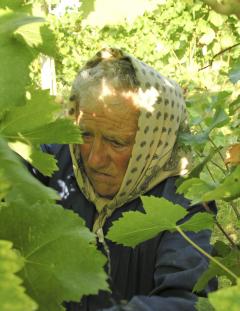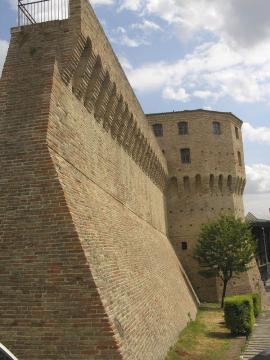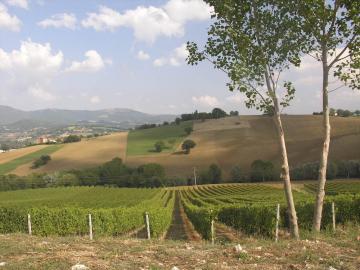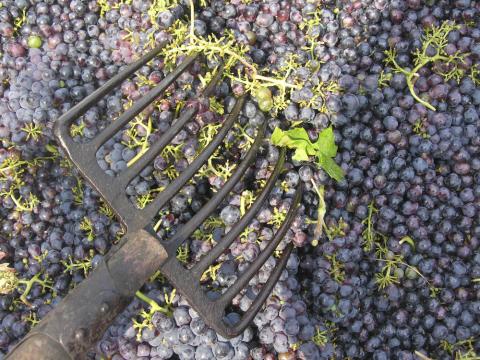Marche Forces
POSTED ON 14/09/2009I was in Le Marche last week on a trip organised by the knowledgeable Italian specialist Michèle Shah. BBC.co.uk/weather’s gloomy forecast had been for heavy showers Wednesday to Saturday, so I took my umbrella. Just as well because it was gloriously sunny and warm for most of the time, although it did rain for 5 minutes when I was in Serrapetrona, whose quirky red spumante, Vernaccia di Serrapetrona, was Le Marche’s first DOCG. Not that this small Adriatic region halfway down Italy’s eastern seaboard has a huge number of DOCGs. In fact it only has one other, Rosso Conero Riserva (from 2004), while verdicchio, its greatest claim to fame, has just been granted the DOCG for the 2009 vintage.
 Harvesting verdicchio
Harvesting verdicchio
Yes, Le Marche is basically about verdicchio, the versatile white grape variety grown mainly in the DOC area inland of Ancona known as Jesi Classico with another small area, Matelica, further west towards the Apennines. But typically for a small Italian region, it has a plethora of interesting, medium to high quality grape varieties and styles. Best of all, the region has managed to retain its individuality and authenticity, escaping the trap so many other regions around the world have fallen into of being seduced by Parker ratings and an overrreliance on international grape varieties. For stats lovers, annual wine production is around 20 million bottles of wine from 20,000 hectares of vineyards, of which over a third are DOC and just under half of the Marche’s production is made up of red wines. The rest is predominantly verdicchio, in its three DOCs of Jesi Classico, Jesi, and Matelica.]
There’s a downside of course. Marketing a region of 15 DOCs and 2 DOCGs is not easy, especially when your best known red, Rosso Conero, isn’t very well-known or appreciated much outside the region. Or when your best white, verdicchio, is little understood because most verdicchio that sells in the UK for instance, tends to be of the cheap and cheerful everyday variety, giving it the image of a simple Italian dry white that’s barely of any greater interest than pinot grigio.
 Jesi
Jesi
Yet after the tastings and visits last week, I realized that verdicchio is not just a high quality grape when it’s handled well, but it’s enormously versatile. It can produce mouthwateringly crisp dry whites for seafood, richer, more intense styles that recall fine Loire chenin, aged whites that taste like white burgundy, not to mention spumante and passito styles. Rosso Conero too, grown around the high Monte Conero which plunges into the sea, can be deliciously juicy and food friendly, and although consultancy can be a dirty word in some regions, it seems to me that the influence of the consultants employed by some of the top estates has been largely beneficial. There are many lovely wines that speak of their location without any undermining of regional authenticity.
 Rosso Conero at Le Terrazze
Rosso Conero at Le Terrazze
I stayed in the walled city of Jesi, heart of Verdicchio dei Castelli di Jesi. It’s a stunningly pretty small city and almost totally unspoilt by tourism despite the fact that the Marche boasts over 100 cities with art galleries, museums and theatres, not to mention 180km of sandy and rocky beaches. Typically, vineyards climb up the wooded hillsides that line the Marche’s transverse valleys, bisected by rivers running from the Apennines to the Adriatic. With the imposing peaks of the Apennines in the far distance, its steep hills and valleys, with their colourful patchwork of grain, sunflower and olive groves (a legacy of the mezzadria, or sharecropping system), remind you a little of Piedmont with a brushstroke of Tuscany for extra scenic beauty.
 Verdiccio di Matelica
Verdiccio di Matelica
The Hotel dei Nani (Dwarfs Hotel, don’t ask) where I stayed is welcoming family establishment with a good restaurant attached, a bit noisy on the street side (I changed rooms for the quieter option). There are plenty of good restaurants in Jesi and in most of Le Marche’s pretty towns. My favourite in Jesi is Chichibio, which does a delicious fresh seafood salad, fine lasagna and paccheri (a hollow packet-shaped pasta), two of the region’s specialities and the best cooked sausage ever.
 Pacchere
Pacchere
Talking of sausage, a big fat, soft sausage called ciauscolo, is another regional speciality. Half pork meat, half pork fat with various types of seasoning, often wine, it’s very bad, so bad in fact that I had to bring two home with me. Other excellent restaurants worth visiting include the Taverna degli Archi in Belvedere Ostrense and a new fish restaurant in Erard.
 Bringing in sangiovese at Moroder
Bringing in sangiovese at Moroder

